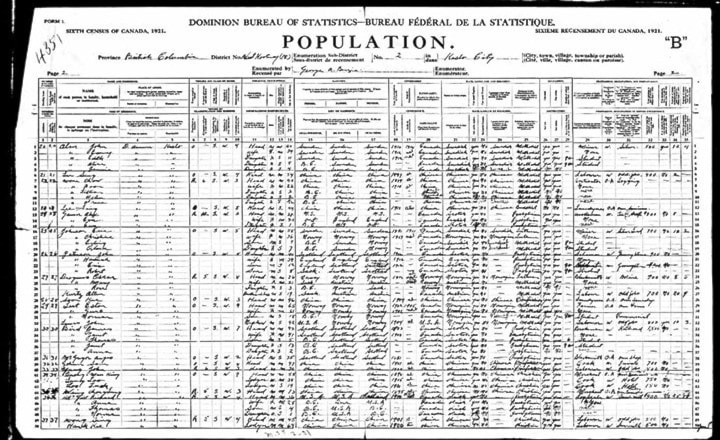For genealogists, it’s like Christmas in August.
Following a two-month delay, nearly 200,000 pages from Canada’s 1921 census went online last week, providing a wealth of raw data for family historians to comb.
Under the Statistics Act, census information is closed for 92 years for privacy reasons, but afterward it’s released by Library and Archives Canada.
The census of June 1, 1921, saw an army of 11,700 enumerators record data by hand on nearly 8.8 million people across the country, including ages, birthplaces, occupations, and place of residence.
Unlike the 1901 and 1911 censuses, the returns have not yet been indexed, so it can be a bit of a slog to find someone: you can’t search by name so need some idea where they lived. Even then, not everyone is where you’d expect them.
A cursory browse reveals several anomalies and curiosities for our area:
• A Profili family (Eugene, Paulina, and their five children) lived at a place between Tadanac and Birchbank called Newtonia. The derivation is probably just “new town” but where was it?
• Doukhobor communities are enumerated separately. The largest in West Kootenay was Brilliant with over 2,700 residents, followed by Glade at more than 600. Curiously, there’s also a place near Nelson called Quory, presumably a misspelling of Quarry, with 13.
Historian Jon Kalmakoff theorizes this was a communal settlement on Grohman Creek otherwise known as Skalistoye, which means rocky or craggy in Russian. Of 30 arable acres, orchards grew on only four, while the rest was barren.
• The Nelson provincial jail is also enumerated separately, and recorded the names of 23 inmates.
• The census records people otherwise marginalized and omitted from sources such as civic directories and voters lists, especially the Chinese.
Nelson’s Chinatown, around Lake and Front streets, had about 130 people — all but two of whom were men, many with wives in China.
The exception was bootmaker Chang Kei, who lived with wife Chon Shee and their BC-born children William and Mary. Similarly, Kaslo logging contractor Chow Won lived on D Avenue with wife Foon and their young daughters Lillian and Helen.
The census was taken two years before the Exclusion Act banned Chinese immigration to Canada.
• Salmo’s Japanese community, which stood at 50 a decade earlier, was down to 11. It consisted of six men working in a logging camp for contractor Setsuzo Miyashi (in other sources spelled Miyazaki), whose family was present: wife Yone, and their BC-born kids, Takahiro, Ayako, and Fumiko, ages four, three, and three weeks.
• How were prostitutes recorded?
In Waneta, madam Rosie Ayres, who later plied her trade in Rossland and Nelson, is recorded as an hotelkeeper. In Sandon, Lena Paul and Fanny Pickett were each said to be running boarding houses.
Nelson’s brothel district is conspicuously absent, except for madam Agnes West at 608 Lake Street, who likewise claimed to be running a boarding house, though none of her “boarders” were listed. They did appear on the 1911 census, however, with their occupations listed as “inmates.”
You can find the whole census at tinyurl.com/l8fad23.
This story will appear in the West Kootenay Advertiser on August 15.
